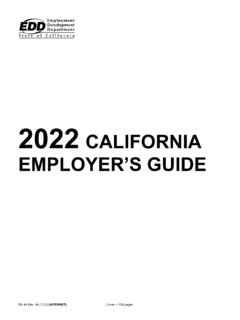Transcription of Who Regulates Whom? An Overview of the U.S. Financial ...
1 Who Regulates whom ? An Overview of the Financial Regulatory Framework Updated March 10, 2020 Congressional Research Service R44918 Who Regulates whom ? An Overview of the Financial Regulatory Framework Congressional Research Service Summary The Financial regulatory system has been described as fragmented, with multiple overlapping regulators and a dual state-federal regulatory system. The system evolved piecemeal, punctuated by major changes in response to various historical Financial crises. The most recent Financial crisis also resulted in changes to the regulatory system through the Dodd-Frank Wall Street Reform and Consumer Protection Act in 2010 (Dodd-Frank Act; 111-203) and the Housing and Economic Recovery Act of 2008 (HERA; 110-289).
2 To address the fragmented nature of the system, the Dodd-Frank Act created the Financial Stability Oversight Council (FSOC), a council of regulators and experts chaired by the Treasury Secretary. At the federal level, regulators can be clustered in the following areas: Depository regulators Office of the Comptroller of the Currency (OCC), Federal Deposit Insurance Corporation (FDIC), and Federal Reserve for banks; and National Credit Union Administration (NCUA) for credit unions; Securities markets regulators Securities and Exchange Commission (SEC) and Commodity Futures Trading Commission (CFTC); Government-sponsored enterprise (GSE) regulators Federal Housing Finance Agency (FHFA), created by HERA, and Farm Credit Administration (FCA).
3 And Consumer protection regulator Consumer Financial Protection Bureau (CFPB), created by the Dodd-Frank Act. Other entities that play a role in Financial regulation are interagency bodies, state regulators, and international regulatory fora. Notably, federal regulators generally play a secondary role in insurance markets. Regulators regulate Financial institutions, markets, and products using licensing, registration, rulemaking, supervisory, enforcement, and resolution powers. In practice, regulatory jurisdiction is typically based on charter type, not function. In other words, how and by whom a firm is regulated depends more on the firm s legal status than the types of activities it is conducting.
4 This means that a similar activity being conducted by two different types of firms can be regulated differently by different regulators. Financial firms may be subject to more than one regulator because they may engage in multiple Financial activities. For example, a firm may be overseen by an institution regulator and by an activity regulator when it engages in a regulated activity and by a market regulator when it participates in a regulated market. Financial regulation aims to achieve diverse goals, which vary from regulator to regulator: market efficiency and integrity, consumer and investor protections, capital formation or access to credit, taxpayer protection, illicit activity prevention, and Financial stability.
5 Policy debate revolves around the tradeoffs between these various goals. Different types of regulation prudential (safety and soundness), disclosure, standard setting, competition, and price and rate regulations are used to achieve these goals. Many observers believe that the structure of the regulatory system influences regulatory outcomes. For that reason, there is ongoing congressional debate about the best way to structure the regulatory system. As background for that debate, this report provides an Overview of the Financial regulatory framework. It briefly describes each of the federal Financial regulators and the types of institutions they supervise.
6 It also discusses the other entities that play a role in Financial regulation. Who Regulates whom ? An Overview of the Financial Regulatory Framework Congressional Research Service Contents Introduction .. 1 The Financial System .. 1 The Role of Financial Regulators .. 2 Regulatory Powers .. 2 Goals of Regulation .. 3 Types of Regulation .. 5 Regulated Entities .. 6 The Federal Financial Regulators .. 7 Depository Institution Regulators .. 11 Office of the Comptroller of the Currency .. 14 Federal Deposit Insurance Corporation .. 14 The Federal Reserve .. 15 National Credit Union Administration .. 15 Consumer Financial Protection Bureau .. 15 Securities Regulation.
7 16 Securities and Exchange Commission .. 16 Commodity Futures Trading Commission .. 19 Standard-Setting Bodies and Self-Regulatory Organizations .. 20 Regulation of Government-Sponsored Enterprises .. 21 Federal Housing Finance Agency .. 21 Farm Credit Administration .. 21 Regulatory Umbrella Groups .. 22 Financial Stability Oversight Council .. 22 Federal Financial Institution Examinations Council .. 23 Nonfederal Financial Regulation .. 24 Insurance .. 24 Other State Regulation .. 24 International Standards and Regulation .. 25 Figures Figure 1. Regulatory Jurisdiction by Agency and Type of Regulation .. 10 Figure 2. Stylized Example of a Financial Holding Company.
8 11 Figure 3. Jurisdiction Among Depository Regulators .. 13 Figure 4. International Financial Architecture .. 26 Figure A-1. Changes to Consumer Protection Authority in the Dodd-Frank Act .. 27 Figure A-2. Changes to the Oversight of Thrifts in the Dodd-Frank Act .. 28 Figure A-3. Changes to the Oversight of Housing Finance in HERA .. 28 Who Regulates whom ? An Overview of the Financial Regulatory Framework Congressional Research Service Tables Table 1. Federal Financial Regulators and Who They Supervise .. 8 Table B-1. CRS Contact Information .. 29 Appendixes Appendix A. Changes to Regulatory Structure Since 2008 .. 27 Appendix B. Experts List .. 29 Contacts Author Information.
9 29 Who Regulates whom ? An Overview of the Financial Regulatory Framework Congressional Research Service 1 Introduction Federal Financial regulation encompasses varied and diverse markets, participants, and regulators. As a result, regulators goals, powers, and methods differ between regulators and sometimes within each regulator s jurisdiction. This report provides background on the Financial regulatory structure in order to help Congress evaluate specific policy proposals to change Financial regulation. Historically, Financial regulation in the United States has coevolved with a changing Financial system, in which major changes are made in response to crises.
10 For example, in response to the Financial turmoil beginning in 2007, the Dodd-Frank Wall Street Reform and Consumer Protection Act in 2010 (Dodd-Frank Act; 111-203) made significant changes to the Financial regulatory structure (see Appendix A).1 Congress continues to debate proposals to modify parts of the regulatory system established by the Dodd-Frank Act. This report attempts to set out the basic frameworks and principles underlying Financial regulation and to give some historical context for the development of that system. The first section briefly discusses the various modes of Financial regulation. The next section identifies the major federal regulators and the types of institutions they supervise (see Table 1).
















